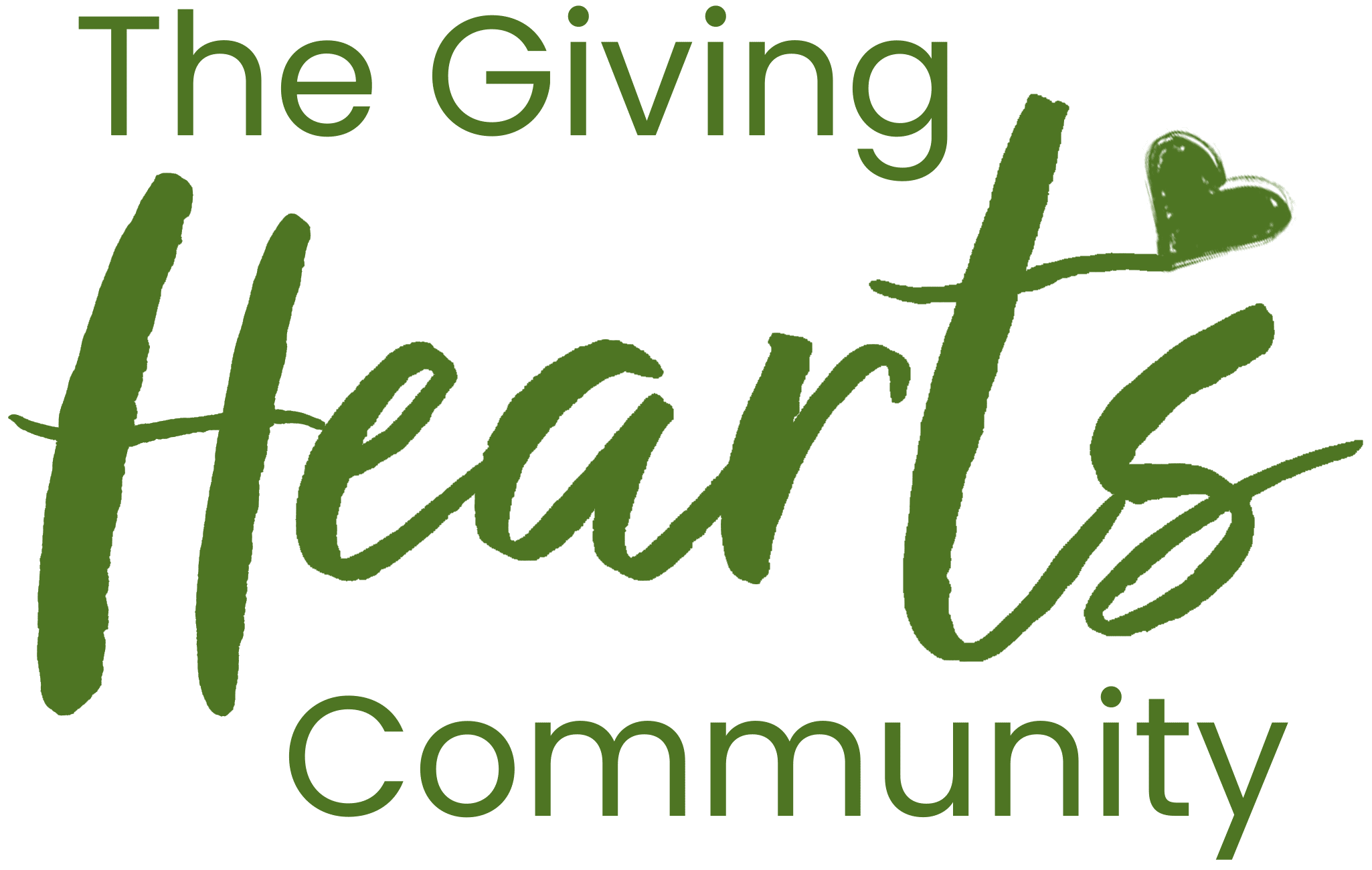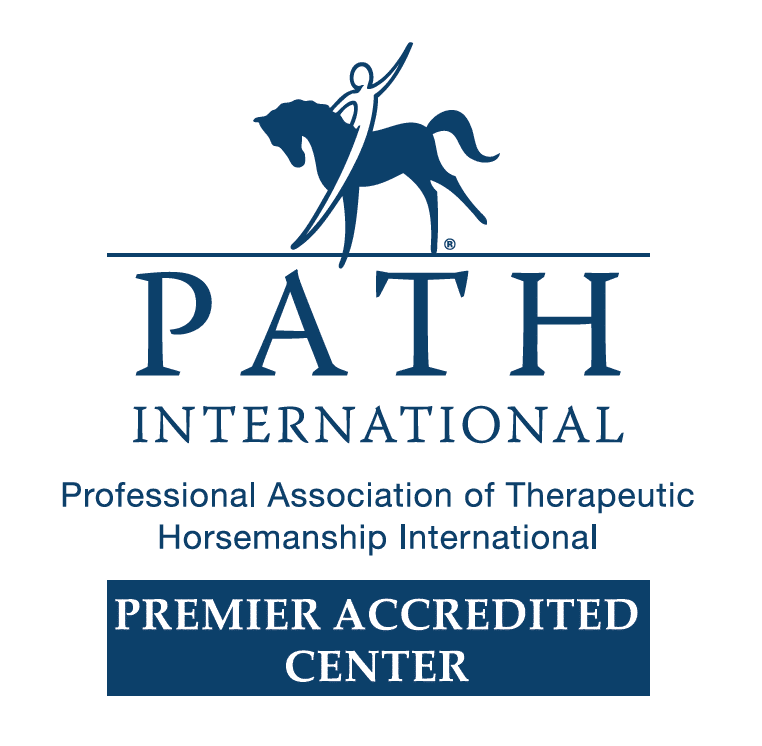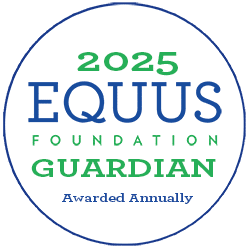This content has been archived. It may no longer be relevant
We are very pleased to share with you a special guest interview with para dressage rider and disability advocate, Hanna Avery.
In high school, Hanna loved to ride horses, run, hike, and mountain bike. She was even a top runner on her school’s track and cross country team. However, in 2019, Hanna was involved in a motor vehicle accident that would change her life forever. Hanna’s incredible story attests to the power of perseverance and reminds us that when you believe in yourself, anything is possible. What’s more, she does not hesitate to humbly give credit to those who have supported her throughout her triumphant journey. According to Hanna, “the only reason I am walking today is because of the amazing physical benefits of horseback riding”. With her service dog Aster by her side, Hanna refuses to let anything stop her from achieving her dreams. For Hanna, one of those dreams is to connect people with horses: “I love connecting with people and would love to make a career out of connecting people and horses in the same spaces in a way that anyone can experience these cool creatures”.
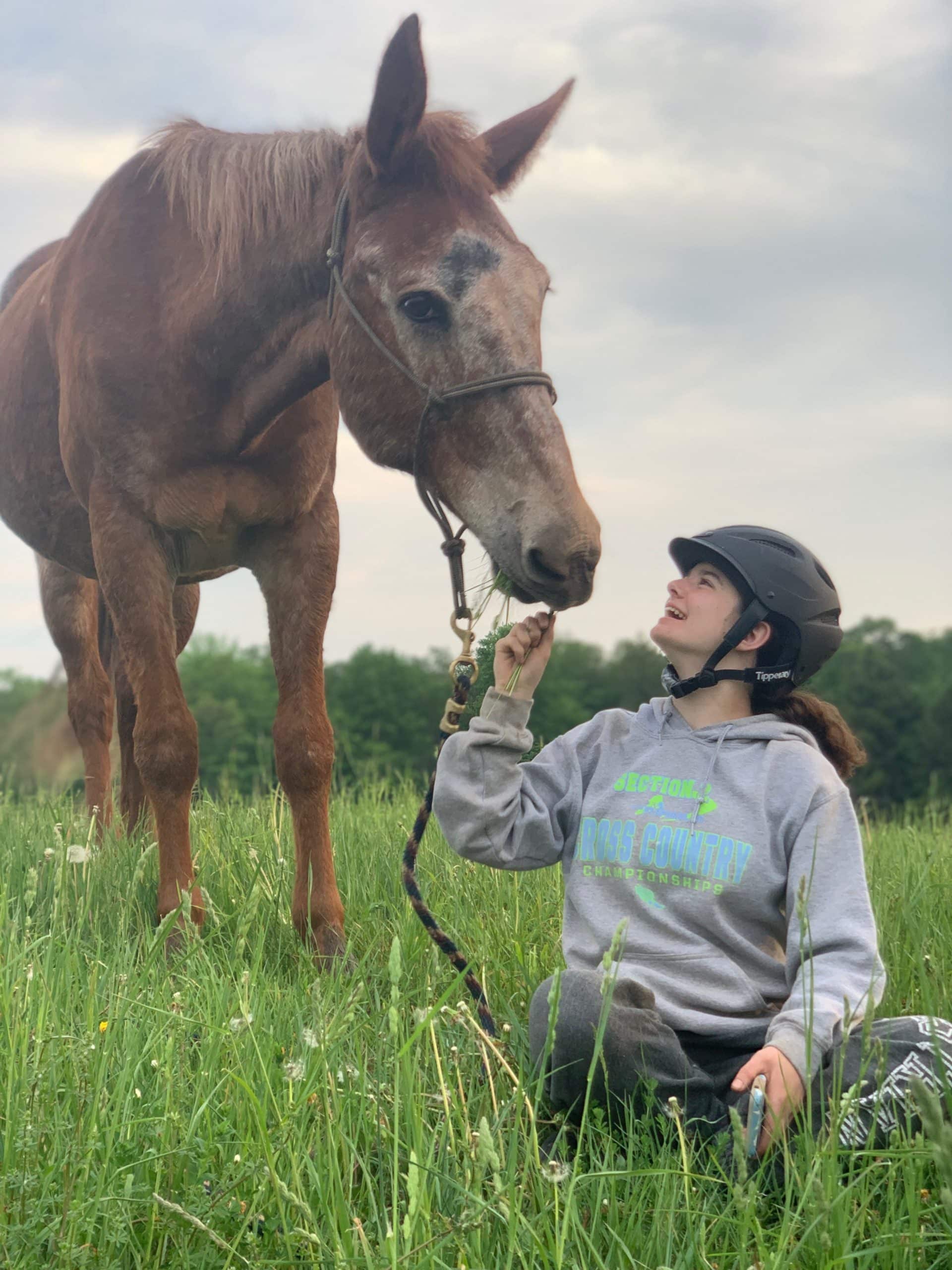
What got you interested in horses?
Hanna: I had wanted to take lessons for as long as I can remember. When I was much younger, I would beg every Christmas and birthday to ride, but at the time my family didn’t have the means to do so. I started riding when I was 13 when I was given the opportunity to ride at a horse camp under a scholarship and the rest is history. I began doing farm chores around local farms in exchange for time in the saddle. It wasn’t until my junior year of high school when I was able to take formal riding lessons with money I saved up from my job. When I entered college, I was intending to study pre-veterinary, but fell in love with the equine program and decided that I wanted to be able to help provide opportunities in the equine world to kids who may have been in my financial situation growing up and share my passions and the partnership with horses that can be found with them.
Do you have a specific riding discipline you are interested in?
Hanna: I am a para dressage rider. I primarily ride dressage, but also dabble in western and jumping as well. But to me, nothing beats the level of connection and engagement found between my horse and I than when we are dancing together.
“My mom told me the first question I asked the doctors after being told that I may not walk again was ‘When could I ride'”
According to your Instagram account, you were diagnosed with spina bifida occulta, chiari malformation, and L4 incomplete SCI. Can you describe how this affects your day to day experiences and working with horses?
Hanna: I was diagnosed with spina bifida occulta at 12 years old after a long bout of kidney and bladder dysfunction. My lesion had minimal impact on my mobility at the time. A few years later the chiari was found by accident as well. Chiari malformation is when brain tissue extends into the spinal canal which restricts spinal fluid flow and causes a vast variety of neurological symptoms which for myself manifests like living with a constant concussion. Through my high school years, it was well managed by therapies and medications. In high school I was extremely active. I was a top runner on my school’s track and cross country team, rode horses and enjoyed lots of hiking and mountain biking. In 2019, I was involved in a MVA that caused an incomplete spinal cord injury, which greatly impacted my life and my riding. It completely changed everything about how I had to live as at the time of injury the prognosis on my ability to walk independently was up in the air. I am partially paralyzed due to my injury and struggle with proprioception, and coordination. I cannot feel my legs at all below my knees and have a drop foot. It was the end of my running career. But I simply refused to make it the end of my riding career. My mom told me the first question I asked the doctors after being told that I may not walk again was “When could I ride”. Because of the loss of strength and function in my legs, I can’t really give leg aids while riding and rely on other aids to communicate with my horses such as my seat, my voice and artificial aids like a whip to give cues that my legs no longer can give. I am not able to put my heels down as my ankles aren’t strong enough to support weight in my legs in my stirrups as they will collapse. My legs also move a lot when I ride, being affectionately named “flappy feet ” by my peers because my feet flap as we trot. This movement also makes keeping stirrups on my feet challenging and dangerous as my feet will often slide too far in or my feet will plop out of the stirrups, requiring us to adapt my stirrups, or take them off completely. I also have the world’s most atrocious posting trot haha. Due to chiari, a big concern we have is harsh head movements, even just standing up too fast, can make me very dizzy and in extreme cases can cause me to blackout. So I struggle with some tasks such as picking feet due to bending over. I also struggle with a lot of the day-to-day barn life such as lifting heavy items, mounting and dismounting, and walking on uneven surfaces. My day to day looks like fatigue, chronic nerve pain, struggles with walking and balance, dizzy spells, light and noise sensitivity, and falls. I lose my balance pretty easily, so a lot of my life is how to prevent falls, constantly being aware of the ground underneath my feet, being worried about something knocking me over and hitting my head.
You went through a lot of therapy after your accident, what was your experience “getting back into the saddle”? What helped you stay motivated to ride again?
Hanna: Honestly, riding played a large part in my therapy of getting back on my feet more than anything. I was riding again before I was walking and I think that is my proudest achievement in life. I was incredibly determined, and a bit stubborn about it. My professors have used the term headstrong to describe me numerous times in this adventure. I started riding again in late February 2020, about 5 months post accident. And we basically started from square one again on the lead line just trying to help reestablish my balance without my legs to help me. And then we graduated to the lunge line and then to riding independently. At first, I was still using forearm crutches to get around, so we had to learn how to get creative and introduce the horses to my new way of getting around. It wasn’t long before I was able to catch, lead, tack up and mount the horses independently on crutches. Riding played such a key role in helping improve my mobility out of the saddle and about one year after the accident I had transitioned off of the crutches to using AFO braces and a cane, and then eventually just braces. The only reason I am walking today is because of the amazing physical benefits of horseback riding. In a way, my injury deepened my connection with horses. I had to learn to put a level of trust in them I didn’t have to before. I was relying on them as they relied on me at the same time. I think the communication we can have with our horses is something so incredibly unique. It’s like they know when I get on them. And are always so careful to help keep me safe and take such good care of me. I remember the first time I rode tackless. It was something unbeatable. It’s a level of trust in a horse I don’t think I could have put into horses four years ago.
At Main Stay, we have a lot of ways to adapt and provide support for our riders. We have adaptive equipment, volunteers, certified instructors, amazing animals that are specifically trained. We strive to provide a community of support. What kind of support do you have and how did it help you on your riding journey?
Hanna: I will boast about it everyday. I have the most incredible support system. From my college professors and instructors, to my peers, to my medical team, to the horses themselves. I wouldn’t have been able to do any of it without them. My instructors have been along for this ride just as much as me, having to get creative and adapt their traditional instruction as they learn with me. I am so thankful for them. I could not be the rider I am without them. In addition to the most amazing people in my life, adaptive techniques in the saddle have allowed me to ride and compete at the same level as my able bodied peers and have turned some of the challenging parts of my riding into assets. The biggest adaptation in the saddle is my stirrups. Because of the lack of function and sensation in my lower leg, my feet move around as I ride so I lose my stirrups so I either need an adapted stirrup or no stirrups. Most of the time I am found riding without stirrups on my saddle at all as I personally have found them to become annoying. This just allows my legs to move along without any worry about getting tangled or caught, using my seat and core to balance me in the saddle. When I ride with stirrups I need to use elastic rubber bands to secure the ball of my foot to the stirrup, a FEI approved and extremely common adaptation used in competitive para-dressage all the way up to the Paralympics. This mechanism keeps the iron on the ball of my foot, preventing the foot from going too far in and set in a way that would release the band if too much weight was added in the case of a fall. I am currently working on upgrading to magnetic stirrups which have the same concept of holding the toe on the footplate, but releasing the foot with weight. In addition to stirrup adaptations I ride with a grab strap or neck strap to help balance as needed, and ride with one or two dressage whips, which serve as my legs when I ride, helping to give leg cues to ask for lateral movement. When I mount, I use an extra tall wooden mounting block so that I don’t have to put my left foot in the stirrup and can just slide into the saddle. I also have taught the horses to dismount at the mounting block as well, or have a spotter while dismounting to prevent a harsh impact. Our goal in working around horses is to do things that are as minimally impact on my body To compete using these adaptations, I compete under what is called a dispensation certificate, which is the same concept as an accommodation letter to allow show venues to be aware that my aids are required because of a disability and allows me to compete alongside able bodied riders on an even playing field.
“So many amazing things have come out of my life, even in my darkest of nights”
Your pictures and posts are so positive and inspiring, do you have any advice for how to handle difficult hurdles?
Hanna: I wish I could say I was always as positive. It has been a tough three years on my mental health and it has been a tortuous journey to regain my confidence. But now, if someone were to ask me if I would go back in time and change the outcome, would I, and the answer is no. I know that in the moment of such a life changing event, it can seem like your whole world is crashing down. It can be hard to picture your life changing so drastically. It can be either to get stuck in the bad part or only constantly be searching for the positive. I encourage people to give themselves the adequate time to process and grieve change, as it is healthy to be sad and frustrated with it. It’s okay to miss a part of you that isn’t there anymore . But also, stay true to yourself and your passions and dream big because even the darkest night can be illuminated by your fire. Something may seem impossible at the time, but that just means your fire needs a bit more time to burn. So many amazing things have come out of my life, even in my darkest of nights. Yes, I miss doing things I used to be able to do, but ive been opened up to an amazing community of people where I can use my story to connect with others who also may be struggling.
You are studying equine management and communications, how is that going and how do you see using the knowledge from that degree?
Hanna: The biggest thing life has taught me is that horses are truly my passion, and I wanted to be able to turn it into a career. Before my accident, my dreams were to run a facility of my own. And maybe one day I still can. But my goals have adapted with me a bit more as I have desired to combine my hobbies of photography and graphic design into an asset for my career and began studying media marketing and social media techniques. I would love to use what I learn in school to do just what I am doing now, share with the world the amazing things about horses and the amazing things we can do with them. Over the past few years I fell in love with social media and the ways it can bring people together. I began opening up about my experiences as an equestrian with a physical disability and a service dog handler– educating about these concepts, and advocating for improved accessibility in equestrian sport and society through TikTok and Instagram. I love connecting with people and would love to make a career out of connecting people and horses in the same spaces in a way that anyone can experience these cool creatures.
“I met Aster in April 2021, and since that day, my life has never been the same”
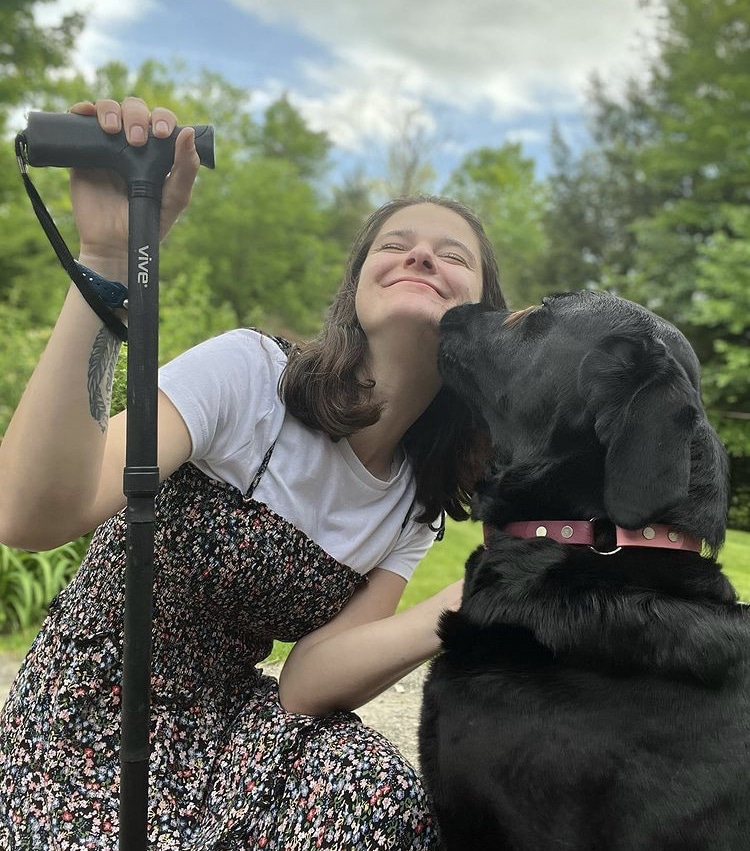
Your instagram account is filled with wonderful pictures of your service dog, Aster. Can you tell us more about her?
Hanna: I met Aster in April 2021, and since that day, my life has never been the same. She has given me so much more of my life and mobility back, doing things that I often required other people to help me with. Aster is a 4 year old black labrador retriever. When she is working she is quiet, kind eyed, and focused on what comes next. But when she’s not? Oh boy. She is a ball of goofy energy who wholeheartedly believes she’s a lap dog. She does so much for me, all with a happy wag in her tail. She is trained in balance assistance, helping make walking easier on my body using her mobility harness. She also can pick up things I drop so I don’t have to bend down. She can carry my groceries so I can have a free hand to use my cane as needed, as well as get things like drinks of water and medications around my living space for me. She is a fan favorite at college for sure, famous for snoring during our exams. Because of her, I am able to live on my own and not need as much help from others. So I can be much more independent in my daily life.
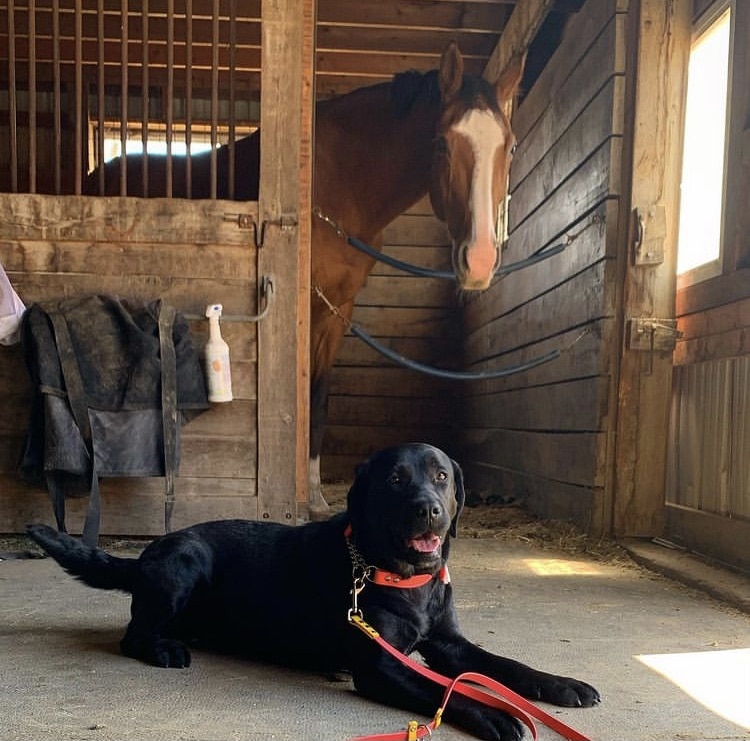
What is it like bringing Aster to the barn? Was it difficult getting her used to that environment?
Hanna: Aster actually used to be a bit nervous of the horses at first. She was always a bit curious, but much preferred her personal space in the barn. So we spent our first summer just helping her become more confident around the barns, making it a fun and positive place for her to be. Eventually, she came around quite quickly, growing more and more confident around the horses. At first being able to handle her, as well as horses was harder for me than anything. Where were we going to put her when I rode? What about when I have to go catch horses? Is she more hassle than help at the barn? We eased her into my everyday barn life slowly taking it at her pace. And now? She is there with me all of the time. She lays quietly on her mat as I work, groom or tack up, and will safely watch from a viewing area while I ride so she is never a hazard for riders in the arenas. She attends shows, clinics, classes, and even has followed along on trail rides. She works in the barn just like she would in any other environment and loves to help out with the farm chores.
Hanna’s incredible story doesn’t stop here! You can follow her journey on Instagram @alluring.aster
